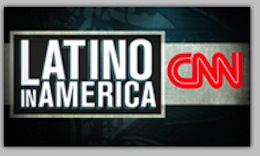CNN's Latino In America documentary puts Soledad O'Brien in the midst of minority explosion
10/21/09 01:40 PM


By ED BARK
CNN publicity materials very charitably tout Latino In America as "one of the most highly anticipated documentaries ever."
Even anchor Soledad O'Brien probably wouldn't go that far. She does go reasonably far and wide, though, in this four-hour sequel to her pair of Black In America documentaries.
Instructive but also repetitive and at times overly sympathetic, Latino In America premieres Wednesday, Oct. 21st at 8 p.m. central and concludes at the same hour Thursday.
Part 1, subtitled "The Garcias," takes viewers on a tour of what has become one of America's 10 most common surnames. It then concludes with a segment on prominent Hollywood Hispanics, including George Lopez, Edward James Olmos and Eva Longoria Parker. Aspiring actor Jesse Garcia also is part of the mix, which at least keeps the overall motif in place.
O'Brien commendably does the legwork here, so you'll see her on camera a lot in the company of both commoners and celebrities. Wednesday's opener begins in Tucson, AZ, with community activist Isabel Garcia the primary focus. She's also the government-paid chief legal defender of Pima County, AZ, and spends a good deal of her time proselytizing on behalf of illegal immigrants.
Isabel Garcia's arch enemy in these efforts is Sheriff Joe Arpaio, who wants all illegals deported. Among those in his bullseye are the so-called "Panda Express 11," all of whom were working at the eatery while knowingly using fake Social Security cards.
O'Brien asks one of the defendants, single mom Araceli Torres, whether she knew it was illegal to use phony identification.
"I know that it's not a crime to work," she replies, which doesn't exactly answer the question. Torres arrived in the United States illegally from Mexico as a seven-year-old with her parents. And Isabel Garcia is fighting on her behalf, arguing that it serves no one to send Torres back to a country in which she has no friends and pledges no allegiance. Her three-year-old daughter is a legal U.S. citizen, which complicates matters.
The next Garcia segment, on Univision chef Lorena Garcia, is pretty much a throwaway. O'Brien chummily accompanies the excitable Lorena on her mission to become a Food Network personality, even though she's supposedly already a big star on the Spanish language network's Wake Up America.
But Lorena wants an English language show and even bigger stardom. And she figures the timing is right because, "our food, our accent, it's cute now."
Latino In America fares better in telling the story of Betty and Bill Garcia, who have moved from their New York neighborhood to Charlotte, NC, where there are comparatively few Hispanics.
Their two teenage sons are "more interested in fitting in than connecting with their Latino roots," O'Brien tells viewers. Says Brian Garcia, "We were raised speaking English and going to McDonald's and stuff."
A family trip back to New York reacquaints the two boys with their parents' heritage. But one wonders whether a pickup basketball game with the jovial Uncle Bobbito will really make any longterm impression.
O'Brien also tells the stories of two troubled Latina teenagers. Cindy is way behind in school due to family obligations dictated by her mother. But she's determined to catch up and graduate on time with her classmates.
Francisca also has issues with her mother, and once tried to commit suicide. But sympathy for both girls is compromised when each "messes up" and gets pregnant. O'Brien notes that they both intend to persevere and achieve their dreams. But no one involved here makes a very convincing case.
Latino In America overall is a decent and well-intended effort by O'Brien. But it also falters at times in its zeal to make some of these stories more inspirational than they really are. Credit CNN, however, for devoting a big chunk of prime-time to what quickly has become America's largest minority population.
At 51 million and counting, there now are more Latinos in the U.S. than in any other country except Mexico. The plusses and problems are growing, too -- and if anything at a faster rate.
GRADE: B-minus
